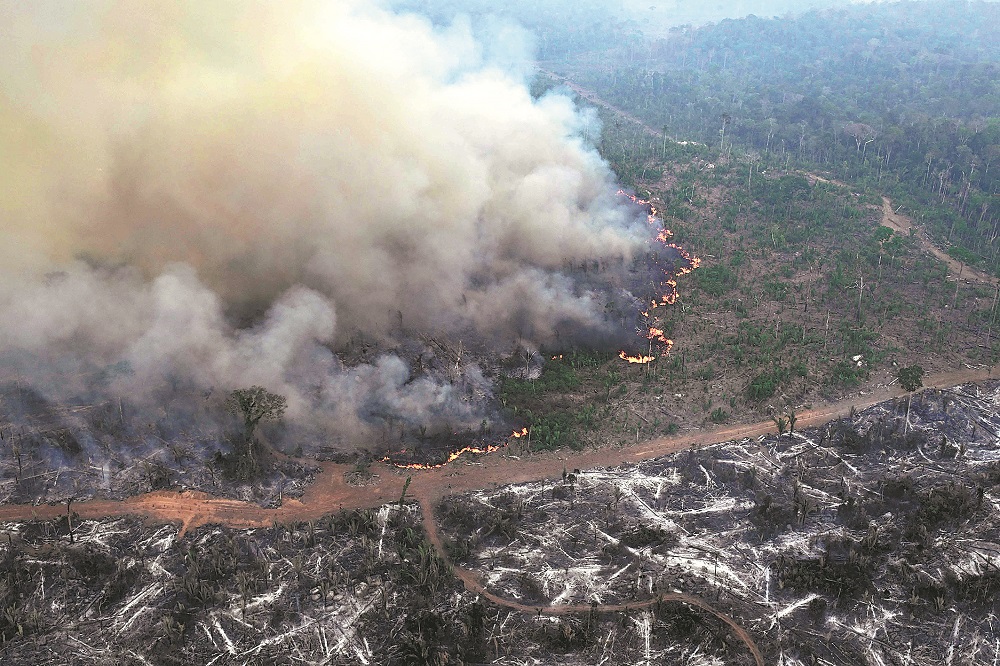'Red alert': Fires drive tropical forest loss to record high


PARIS — Eighteen soccer pitches every minute of every hour of every day — that is the alarming extent of tropical rainforests destroyed last year, in large measure because of fires fueled by climate change, researchers reported on Wednesday.
Tally it all up and the world lost 67,000 square kilometers of precious primary tropical forest, an area double the size of Belgium, last year.
The loss was 80 percent higher than in 2023, according to the Global Forest Watch think tank.
"This level of forest destruction is completely unprecedented in more than 20 years of data," Global Forest Watch co-director Elizabeth Goldman said in a briefing. "This is a global red alert."
Fires are responsible for nearly half of these losses, surpassing for the first time agriculture as the main driver of destruction.
Loss of tree cover last year — from deforestation and fires, deliberate or accidental — generated more than 3 billion metric tons of CO2 pollution, exceeding India's emissions from fossil fuel use over the same period.
Tropical forests, which harbor the highest concentrations of biodiversity, are the most threatened of any forest biomes on the planet.
They are also sponges for CO2, helping to prevent global temperatures from rising even faster than they have.
Forest fires are both a cause and effect of climate change, injecting billions of tons of CO2 in the atmosphere that in turn accelerate warming and the conditions leading to more destructive fires.
The exceptional fires last year were fueled by "extreme conditions" that made them more intense and difficult to control, the authors said.
Climate change driven by the massive burning of fossil fuels and boosted by natural El Nino weather phenomenon made 2024 the hottest year on record, with temperatures averaging more than 1.5 degrees above preindustrial levels.
Historically, most fires in tropical forests are set to clear land for agriculture and livestock, especially the "big four" commodities: palm oil, soy, beef and timber.
Brazil saw 2.8 million hectares of primary forest destroyed last year, two-thirds to fires typically started to make way for soybean and cattle.
Measurable progress
In 2023, Brazil made measurable progress in reducing forest loss during President Luiz Inacio Lula da Silva's first year after returning to office.
"But this progress is threatened by the expansion of agriculture," said Sarah Carter, a researcher at the World Resources Institute in Washington.
The Brazilian Amazon was most affected, with destruction at its highest level since 2016.
Forest protection is high on the agenda of the COP30 United Nations climate conference that Brazil will host in November in the tropical city of Belem.
Neighboring Bolivia's forest loss — 1.5 million hectares — rose by 200 percent last year, with a record 3.6 percent of primary forests destroyed in a single year, mostly because of fires set to clear land for industrial-scale farms, according to the report.
The picture is mixed elsewhere, with improvements in Indonesia and Malaysia but a sharp deterioration in the Republic of Congo and the Democratic Republic of Congo.
While policies have resulted in a slowdown of the extent of forests lost to palm oil plantations, notably in Asia, the destructive footprint of other commodities has expanded, including avocados, coffee and cocoa.
"We shouldn't assume that the drivers are always going to be the same," said Rod Taylor, director of the World Resources Institute's forests program.
"One new driver we are seeing, for example, is linked to mining and critical minerals."
Agencies via Xinhua
































